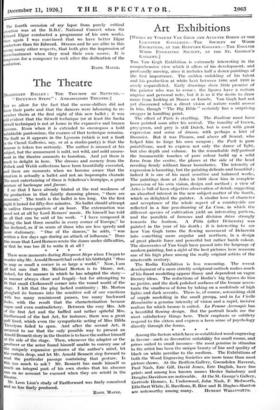Art Exhibitions
[WORKS BY VINCENT VAN GOGH AND AUGUSTE RODIN AT THE LEICESTER GALLERIES.—THE SOCIETY OF WOOD ENGRAVERS, AT TIIE REDFERN GALLERY.—THE ENGLISH WOOD ENGRAVING SOCIETY, AT TILE ST. GEORGE'S GALLERY.] THE Van Gogh Exhibition is extremely interesting in the comprehensive view which it offers of his development, and profoundly moving, since it includes half a dozen paintings of the first importance. The sudden unfolding of his talent and his production at white heat between 1880 and 1890 is surely unparalleled. Early drawings show little promise of the painter who was to come ; the figures have a certain angular and personal note, but it is as if the desire to draw came from looking at Mauve or Israels. Van Gogh had not yet discovered what a direct vision of nature could arouse in him, though " The Big Bible " certainly has a surprising swagger in handling paint.
The effect of Paris is startling. The Banlieue must have been painted soon after his arrival. The tonality of brown, grey-green, and grey is still Dutch, but is used with great expression and sense of drama, with perhaps a hint of Daumier. But it was Pissaro, and above all Seurat, who helped him to forge his own weapon ; the Park is pure pointillisme, used to express not only the dance of light, but also depth and volume. In the remarkable Self-portrait the innumerable touches of pure colour build up a solid form from the centre, the planes at the side of the head receding firmly without linear boundaries. The intensity of expression is haunting, but the painting delicate and beautiful ; indeed it is one of his most sensitive and balanced works. The paintings done at Arles in 1888 show him in complete possession of his own vision, design and method ; a view of Arles is full of keen objective observation of detail, suggesting an absorbed interest in the new subject-matter of the South, which so delighted the painter. A similar love of character and acceptance of the whole aspect of a countryside are reflected in a fine pen-drawing of La Crau, in which the different species of cultivation yield an interesting pattern, and the parallels of furrows and division drive strongly towards the horizon. A Pieta (after Delacroix) was painted in the year of his death ; it is interesting to see how Van Gogh turns the flowing movement of Delacroix into something more angular and northern, in a design of great plastic force and powerful but rather harsh colour. The discoveries of Van Gogh have passed into the language of modern painting, but a sight of the best pictures here reassure one of his high place among the really original artists of the nineteenth century.
The Rodin Exhibition is less reassuring. The recent development of a more strictly sculptural outlook makes much of his fluent modelling appear flimsy and dependent on vague literary ideas. The reductions of Rodin's big figures do him no justice, and the dark polished surfaces of the bronze accen- tuate the smallness of form by taking on a multitude of high lights and dark accents. There is, of course, astonishing skill of supple modelling in the small groups, and in La Vieille Heaulmigre a genuine intensity of vision and a rapid, incisive realism for which bronze is suited. La Femme Accroupie has a beautiful flowing design. But the portrait heads are the Most satisfactory things here. Their emphasis or subtlety respond to the sitters and express a keen sense of psychology directly through the forms.
* * * * Among the factors which have re-established wood-engraving in favour—such as decorative suitability for small rooms, and prices suited to small incomes—the most genuine in stimulus to the artist has been the unique beauty of line and quality of black on white peculiar to the medium. The Exhibitions of both the Wood Engraving Societies are more tense than most picture shows. At the Redfern Gallery, Gwendolen Raverat, Paul Nash, Eric Gill, David Jones, Eric Daglish, have fine prints and among less known names Hester Sainsbury and Douglas Davidson are noticeable. At the St. George's Gallery, Gertrude Hermes, L. Underwood, John Nash, F. Medworth, Ethelbert White, E. Ravilions, B. Rice and B. Hughes-Stanton
are noteworthy among many. HUBERT WRILI NGT-rM4














































 Previous page
Previous page